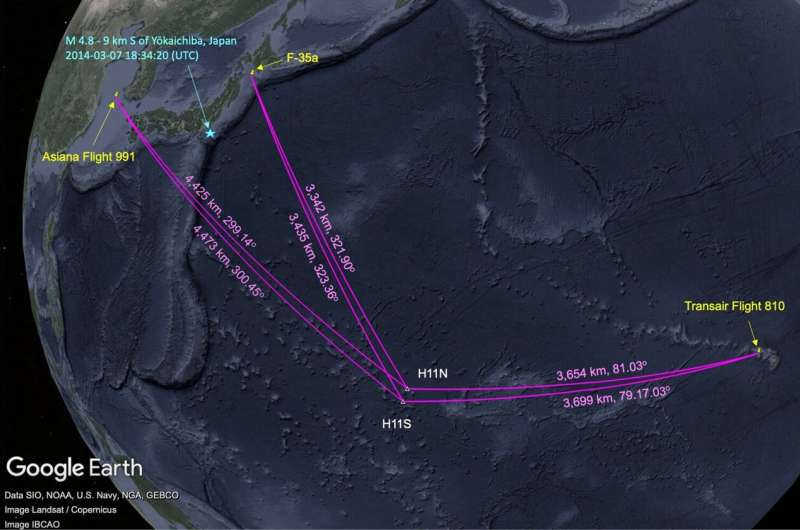This article has been reviewed according to Science X's editorial process and policies. Editors have highlighted the following attributes while ensuring the content's credibility:
fact-checked
peer-reviewed publication
trusted source
proofread
Underwater signals generated by open sea airplane crashes could be key to detecting final resting place of MH370

Signals captured on underwater microphones could be key to locating airplanes such as MH370 when they crash into the ocean, Cardiff University research shows.
More than 100 hours of data, captured by devices known as hydrophones after 10 historical aircraft accidents and one submarine disappearance, were analyzed for the study.
The findings, published in Scientific Reports a decade after the disappearance of MH370, offer recommendations for further investigation of the aircraft's last known location and establish a framework for addressing similar incidents in the future.
Violent ocean impacts such as airplane crashes produce distinctive acoustic signatures which travel vast distances through the water and are recorded by hydrophone technology from various locations on the seabed.
Dr. Usama Kadri, a Reader at Cardiff University's School of Mathematics, said, "Our analysis shows clear pressure signals from previous aircraft crashes were detected on hydrophones, even at distances exceeding 3,000km. In the case of MH370, official investigations concluded the aircraft must have crashed near the 7th arc—the point at which the last communication between the plane and INMERSAT occurred. Further analysis and future research are therefore necessary to fully comprehend the detected signals and their implications for MH370's disappearance."
The study recommends authorities conduct field experiments including controlled explosions or airguns along the 7th arc while monitoring the signals received at surrounding hydroacoustic stations.
With energy levels similar to the impact of MH370, experiments of this kind could reveal insights into the location of the missing aircraft, the study suggests. The experiments would also help develop the use of hydroacoustic technology as a tool for authorities to draw upon when narrowing down potential crash locations for airplanes in the future.
Dr. Kadri added, "Similar exercises were performed in the search and rescue mission for the ARA San Juan, a submarine that vanished off the coast of Argentina in 2017. This shows us that it is relatively straightforward and feasible and could provide a means to determine the signal's relevance to MH370, prior to resuming with another extensive search.
"If found to be related, this would significantly narrow down—almost pinpoint—the aircraft's location. On the other hand, if the signals are found to be unrelated, it would indicate a need for authorities to reassess the timeframe or location established by their official search efforts to date."
MH370 disappeared on Saturday, 8 March 2014, during a journey from Kuala Lumpur to Beijing.
Despite an extensive multinational search effort, the whereabouts of the aircraft and the fate of its 239 passengers and crew remain uncertain.
The research focuses on hydrophone data from the final stage of the aircraft's journey in the Southern Indian Ocean, searching for signals generated near the 7th arc following the official search recommendations.
Data associated with the disappearance stage of the flight around the time of the last communication, in the Gulf of Thailand, was also analyzed to check for unusual signals.
Dr. Kadri said, "The disappearance of MH370 motivated this work because it raised questions about the detectability of aircraft crashes in the ocean and the potential use of hydroacoustic technology to aid in search and rescue efforts. Unfortunately, we've been unable to find a signal with the certainty needed to launch a new search for the missing aircraft.
"However, if the recommendations are followed by the appropriate authorities, we can assess the relevance of the observed signals, potentially shedding light on the location of MH370."
More information: Usama Kadri, Underwater acoustic analysis reveals unique pressure signals associated with aircraft crashes in the sea: revisiting MH370, Scientific Reports (2024). DOI: 10.1038/s41598-024-60529-1




















